As I was watching this version of Pinocchio with my son I began to notice disturbing patterns of cruelty in this seemingly innocent story. The story is engaging and the characters are empathetic, but how is it so easily glossed over that Pinocchio almost kills and eats his best friend? And why is it okay for the Blue Fairy to pretend that she’s dead as a punishment for Pinocchio? A further investigation was warranted.
Most of us know Pinocchio as the adorable Disney character from the 1940 movie that debuted the song “When You Wish Upon a Star”. He is lovable and sweet but he can’t help his naughty streak. He wants nothing more than to be reunited with his father, Gepetto, and to become a real boy. Many people are not aware of the much less wholesome original character.
Carlo Collodi (real name Carlo Lorenzini) wrote Pinocchio as a series for a children’s section in a newspaper in Rome in the years 1881 and 1882. The moral: bad things happen to bad children. The wooden puppet was an evil little thing. There is a cricket in the story that tries to speak to Pinocchio’s conscience but our hero quickly bludgeons him to death. In fact, the character was so unlikable that Walt Disney almost cancelled the production.
At first, Disney’s animators designed Pinocchio literally as a wooden puppet. Walt Disney felt no one could sympathize with such a character. He called for an immediate halt in production. Milt Kahl said that the animators were “rather obsessed with the idea of this boy being a wooden puppet” and felt that they should “forget that he was a puppet and get a cute little boy; you can always draw the wooden joints and make him a wooden puppet afterwards.” Milt Kahl’s design is the one that is known and loved today.
To put Kahl’s design in perspective, it’s interesting to look at older interpretations of Pinocchio’s character design. I found the following images by browsing archive.org:
The story of a puppet : or The adventures of Pinocchio (1892)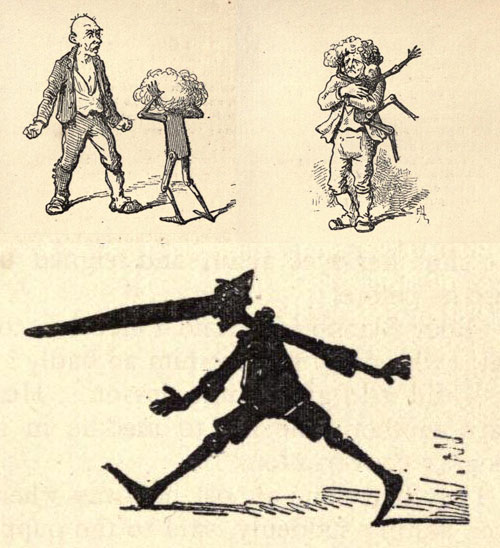 Pinocchio, the story of a puppet, by “C. Collodi” (1900)
Pinocchio, the story of a puppet, by “C. Collodi” (1900) La avventure di Pinocchio, storia di un burattino (1902)
La avventure di Pinocchio, storia di un burattino (1902)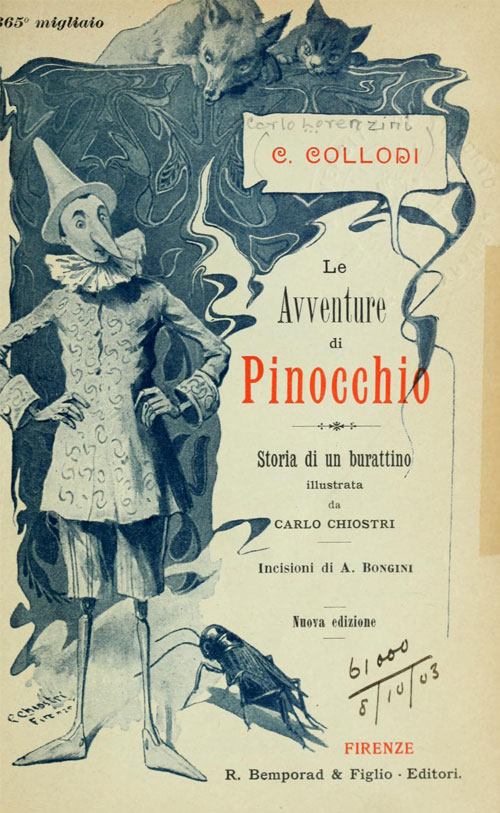 Pinocchio the adventures of a marionette (1904)
Pinocchio the adventures of a marionette (1904)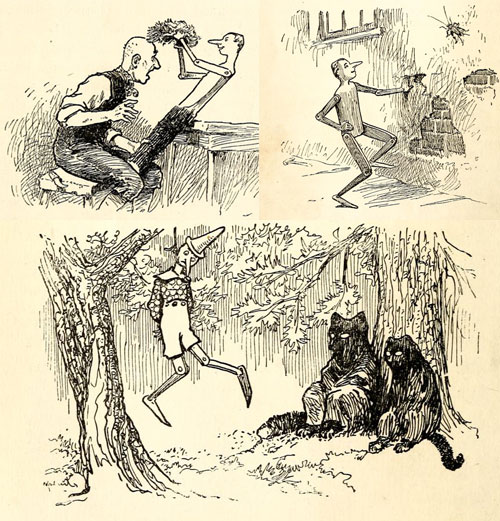 Pinocchio the tale of a puppet (1911)
Pinocchio the tale of a puppet (1911)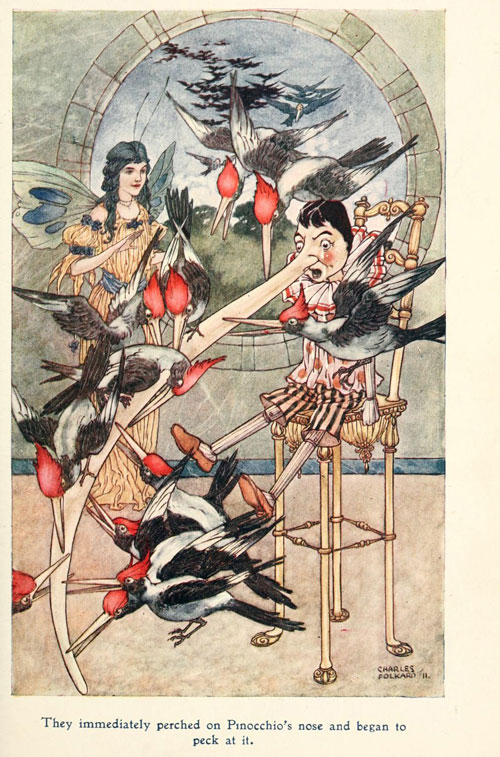
Interestingly, the original series ended with Pinocchio hanged and left for dead by the villainous cat and fox (who were no worse than Pinocchio himself).
“His breath failed him and he could say no more. He shut his eyes, opened his mouth, stretched his legs, gave a long shudder, and hung stiff and insensible.”
The audience was so appalled that the editor asked Collodi to continue the story and resurrect its hero. This is where the Blue Fairy is originally introduced.
Traditional children’s stories and fairytales are often violent and disturbing. The brothers Grimm, who wrote the book that was second in popularity only to the bible in Collodi’s time, saw the stories of the oral tradition as the key component for the creation of human culture and civilized communities. They wrote, in the preface to the first edition of Grimm’s Fairytales:
Where the tales still exist, they live on and no one worries whether they are good or bad, poetic or vulgar. We know them and we love them just because we happen to have heard them in a certain way, and we like them without reflecting on why. Telling these tales is an extraordinary custom — and this too the tales share with everything immortal — that one must like it no matter what others say.
The theme of a sculpture that comes to life is not new. It is prevalent in Greek Mythology. The story of Pygmalion, a sculptor who fell in love with his statue, is well known. Other examples include Daedalus, who used quicksilver to install a voice in his statues, Hephaestus, who created automata for his workshop and Talos, an artificial man of bronze. In recent years, the notion of creating a human-like machine with intelligent behavior has come to life. What was once merely fodder for the imagination is now undergoing the tests of reality and the results are thought provoking.
The theory of the Uncanny Valley, penned in 1970 by roboticist Masahiro Mori, says that robots exist along a spectrum of familiarity – the ones that are not realistic at all are likable, but somewhere between that and indistinguishably human there is a creepy zone. Mori predicted a future where robots look almost perfectly human. He hypothesized that we will always be horrified by such robots.
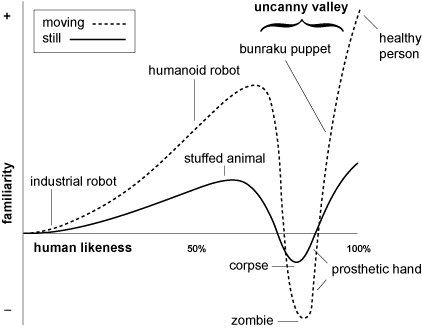
For many years, this theory, which is pertinent to the fields of robotics as well as CGI, has been accepted as an axiom by technologists. More recently, however, it has been put through the rigors of scientific study. Several studies have asserted that the Uncanny Valley doesn’t exist and that we are perfectly comfortable with artificial beings that are almost, but not entirely human. Other studies have shown that it does exist but it’s more of a cliff than a valley. On an anecdotal level, most of us can testify that we have seen movies such as Avatar and video games such as Heavy Rain and we were not shocked and horrified.
Mark Wilson speculates that the real problem is not aesthetics, but artificial intelligence. He writes:
“We’re reaching a cliff of AI, where the height of human knowledge falls off into a wasteland of poorly automated social grace. And where we may theoretically get used to idiotic, omniscient AI–much like we did the PS3’s glassy-eyed depictions of the human figure–there are numerous social concerns that software (let alone society) has only begun to address. For instance, when should you give someone bad news? How should your intonation change based upon context? Or, maybe most challenging for the Googles, Apples and Facebooks: Do you still tell someone the truth when you know they won’t want to hear it? Or when they simply can’t do anything about it?”
Creating an artificial human that you can love and that will love you back is a deep seated human desire. There are many possible reasons for this and many ethical implications to creating such a being. The resulting duality between benign and disturbing is clear to see.